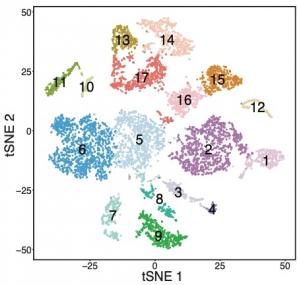
In May of 2019, University of Iowa vision researchers published the first paper in the peer reviewed literature using single-cell gene expression within the human retina. With the aid of high-performance computing, the team was able to characterize gene expression profiles for 8,217 cells corresponding to ten different types of retinal cells. This multidisciplinary approach allowed for the first characterization of gene expression signatures in individual human retinal cell types such as photoreceptor cells and ganglion cells. These gene expression signatures will be incredibly valuable in optimizing retinal cell differentiation protocols for stem cell therapies.
The human retina is a highly specialized tissue that requires many different types of cells to function properly. For example, some retinal cell types detect incoming light for visual perception, while other cell types have supportive roles such as providing nutrients and oxygen. Investigating what genes are being expressed in each of these unique cell types has been of high interest both scientifically and clinically, but large-scale experiments have been impossible to conduct in human tissue until recent technological breakthroughs in single-cell RNA sequencing.
The team was particularly interested in studying how cell types differed between the fovea, the most central area of the retina responsible for detailed vision, and the peripheral retina. Two populations of cells, cone-photoreceptors and Müller cells, demonstrated dramatic gene expression differences based on location of origin. Overall, these comparisons will aid in the search for disease causing mutations with regional disease patterns, including Stargardt disease and macular degeneration.
This single-cell RNA sequencing based study demonstrates great promise for the field of vision research. The multidisciplinary efforts of cell biologists, bioinformaticians, and clinicians can be combined to study both normal vision as well as visual diseases at an unprecedented level of detail. We wish to thank the donors, their families, and the Iowa Lions Eye Bank for their generous and essential role in this research.